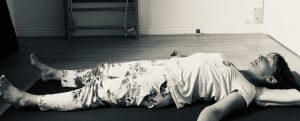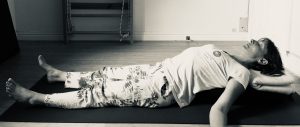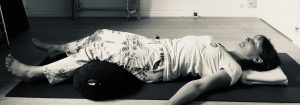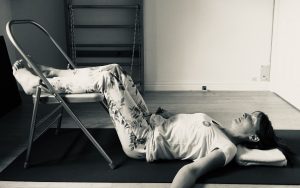Aah, savasana. That lovely bit at the end. Or, that bit when I’m supposed to completely relax but my mind is running in circles. How is it for you? Sometimes we experience a flip between these feelings around savasana on a daily basis. Nevertheless, I cannot advocate strongly enough for savasana as a daily practice. I entreat you not to dismiss or neglect it and not to underestimate its transformational powers over a lifetime.
It’s important to finish each and every practice of yogasana and pranayama with savasana for a number of reasons:
7 Good Reasons to practise Savasana
- It marks the end of the practice, giving a sense of completion and contentment.
- It allows the benefits of the practice, both physical and psychological, to embed and consolidate.
- Even a short savasana is like plugging a device in to re-charge. It’s immensely restorative.
- It is soothing for the nervous system, so reduces symptoms of stress and anxiety.
- It allows the senses to completely rest from their habitual activity, reducing their attachment to external objects.
- It is a bridge between the ‘outer’ aspects of the yoga practice and the ‘inner’ aspects; it allows us to dive deeply inside that inner experience in a safe and secure way.
- It is one of the best preparations for a good death.
Practise for death??
Yes, death. We’ll all get there in the end. Along with the seven characteristics of movement, respiration, sensitivity, growth, reproduction, excretion and nutrition, it’s what we share with every other living organism on the planet. So the more we alienate ourselves from the fact of our own mortality, the more we alienate ourselves from all life on earth (the consequences of this are for another post!). But acknowledging and accepting the fact of our own death is not simple. According to yogic texts, one of the greatest obstacles on the path of successful living is Abhinivesa; attachment to life and fear of death. Of course we feel these things. We’d be inhuman not to. However we can make a dedicated, heartfelt effort to live with the knowledge of our mortality as a way of forging deeper connections during our lifetime with everything that is also alive. To approach life and death as a series of interdependent systems and cycles rather than an individual linear narrative.
One day (if we’re lucky, at a ripe old age and surrounded by those we love) we will each take our very last breath. An inhalation, followed by an exhalation, and then…….(eternal ellipses)….. What our attitude is at that moment and the moments leading up to it, matters. It matters personally because it’ll inform our experience of the transition from being to non-being (as the body-mind we exist as. This is the case whatever you believe may happen after death; something or nothing). It matters more widely because, as has been well observed and thoroughly documented, a ‘good death’ (let’s define that simply as one that is free from fear) is beneficial for everyone.
As the celebrated author and palliative care doctor Kathryn Mannix says:
“By encountering death many thousands of times, I have come to a view that there is usually little to fear and much to prepare for.” 1
Giving birth, giving death
My mother has described her own mother’s graceful, apparently peaceful death as the last and best gift she gave. If a person is able to die without fear, it fills those around them with almost inexpressible love and hope and renewed vigour for living well. Just as women give birth, is it possible to give death? I believe it is but, as Mannox suggests, takes a deal of preparation.
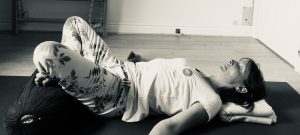
5. ‘Soft abdomen’ with legs crossed on a support, hips on floor plus blanket for head and neck. (This can become uncomfortable for people with stiff hips and groins).
How to do it- stop with the ‘doing’
So, back to savasana. ‘Sava’ means corpse, ‘asana’ means pose. This is the putting down of body, mind and senses in the manner of a corpse. It is the cessation, for a few minutes, of all ‘doing’. Finding comfort in this pose is important, and there are many adjustments you can make to enable this comfort and its attendant spread of awareness to occur (see the images here for some ideas). The form you take may change depending on what your asana practice has included, what your current conditions are, any injuries and so on. Experiment with structure, but once you’re in the pose allow yourself to rest into stillness. Let it be an act of absolute surrender. As if this is the final offering of the final exhalation.
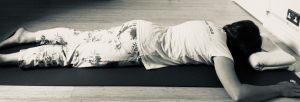
6. ‘Prone’, face down with blanket under forehead or head turned to the side. Toes turned in. Good for respiratory conditions and back pain. If the lower back finds this stressful add a blanket under the abdomen.
It’s my conviction that by consciously preparing ourselves mentally and physically for the moments of dying and death on a daily basis, the precipitous edge of the unknown becomes more familiar and therefore less fearful. It’s a simple equation that is impossible to prove (since we can’t ask the dead people who’ve tried it how it worked out). But one thing I’m sure of; after every good savasana you ‘come back’ knowing without any doubt at all that life is for living.
1 Mannix, K. (2017). With the End in Mind: Dying, Death and Wisdom in an age of denial William Collins

